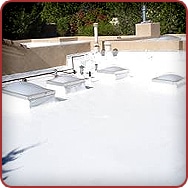(TPO) Thermoplastic Polyolefin – single-ply roofing
 The success of TPO roofing systems today is based on a history of product chemistry and application technology evolution that has passed the test of time. TPO materials were first identified as appropriate for use as roofing membranes in Europe during the 1960’s. Early formulations were based on PVC (polyvinyl chloride) polymers which were compounded with plasticizers for flexibility, stabilizers for UV resistance and dimensional stability, reinforcements for strength and dimensional stability, and pigments for aesthetic appeal. Today, many products are available which still contain these basic elements; others have been introduced which contain other ingredients, but which exhibit similar basic performance characteristics.
The success of TPO roofing systems today is based on a history of product chemistry and application technology evolution that has passed the test of time. TPO materials were first identified as appropriate for use as roofing membranes in Europe during the 1960’s. Early formulations were based on PVC (polyvinyl chloride) polymers which were compounded with plasticizers for flexibility, stabilizers for UV resistance and dimensional stability, reinforcements for strength and dimensional stability, and pigments for aesthetic appeal. Today, many products are available which still contain these basic elements; others have been introduced which contain other ingredients, but which exhibit similar basic performance characteristics.
One of the very earliest recognized benefits of these membrane systems relates to their seaming technology, the most critical area for flexible membrane performance. TPO materials, be definition, can be joined together by chemical or heat welding, both of which produce permanent bonds of extremely high strength. For roofing, heat welding is preferred and special manual and automatic welding equipment has been developed to produce fused, impermeable seams. The equipment which is clean, readily maintainable and easy to use can be adjusted to accommodate different ambient weather conditions to maximize seam integrity.
Another characteristic of TPO roofing systems is versatility. Their ability to be installed fully adhered, mechanically fastened, as well as ballasted, ensures their applicability to almost any roofing situation. Barrels, domes, and steep slopes can be accommodated as well as large expansive flat roofs.
Industrial buildings , airports, and huge factories have all realized the benefits of TPO roofing, as have small strip malls, individual fast-food or convenience stores and institutional structures such as schools, museums and hospitals.
A further benefit of TPO roofing materials is their ease of maintenance and repair. When properly formulated and installed, these materials have demonstrated service lives in excess of 30 years. Periodic inspections should be performed as with any roofing systems; the remedy of problems for normal “wear and tear” is generally uncomplicated. Because of their chemical make up, they do not require re-coating, re-surfacing, or re-saturating for them to retain their as-manufactured properties. Any tears, cuts or seam openings are easily corrected by using the same welding techniques as are originally used.
Installation of new fixtures or penetrations through the roof surface is easily achieved by joining new flashing material to the in-place installation. This feature readily translates into lower maintenance costs, as smaller amounts of materials and less labor are required for their completion.
If you are interested in learning more about the commercial roofing systems that RC Roofing offers, please contact us.
Getting started is easy.
Call (858) 274-8920
for our free, no hassle estimate
